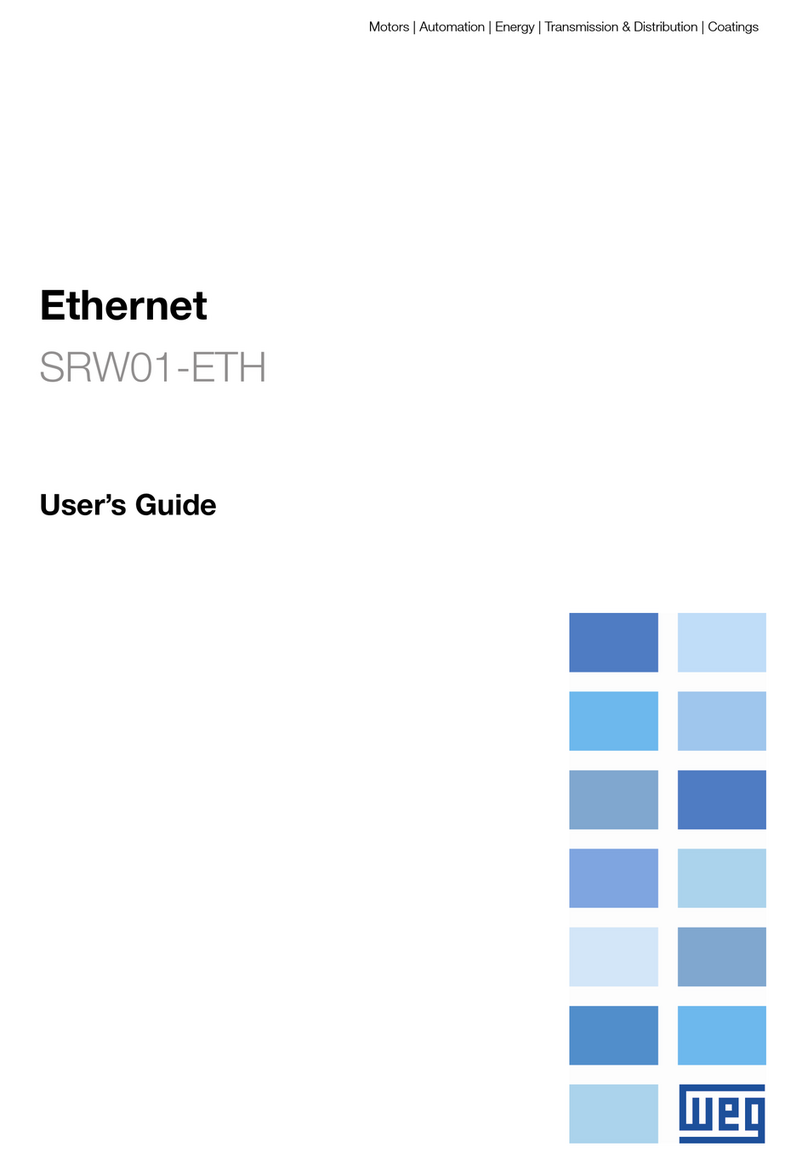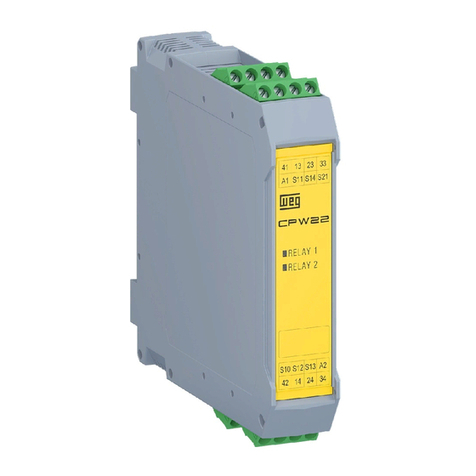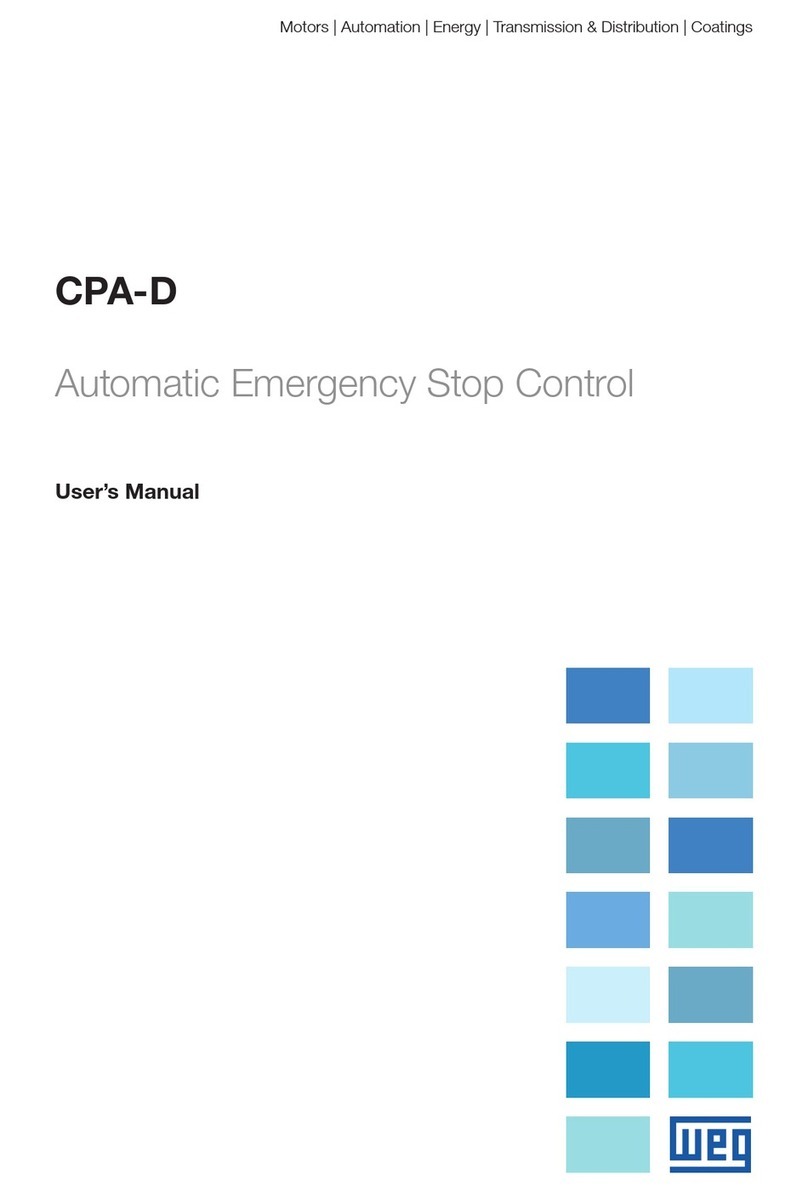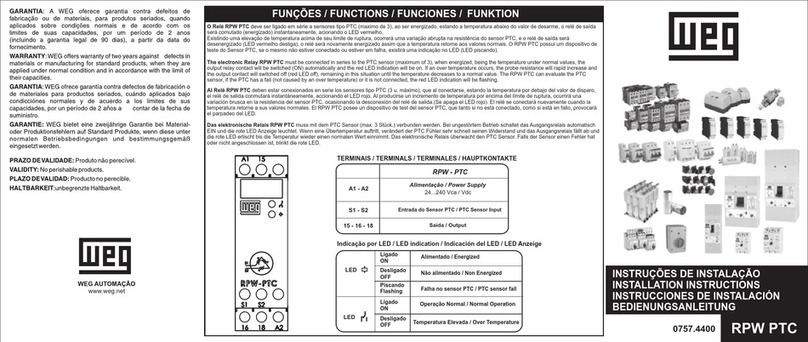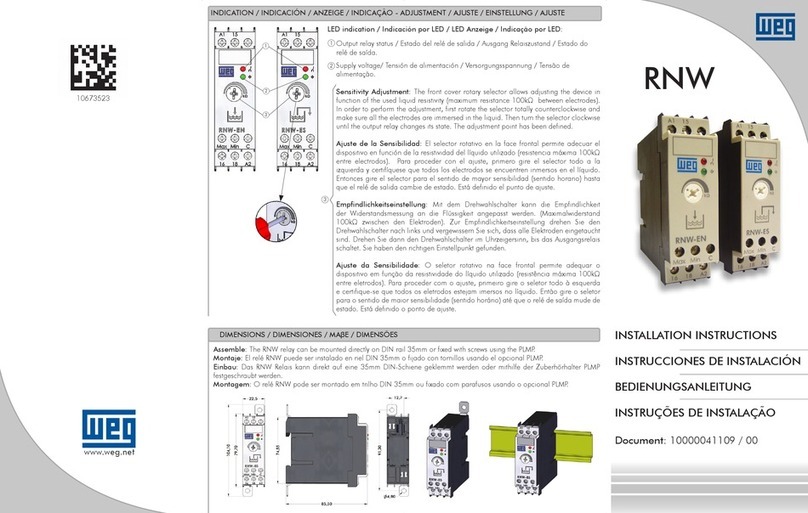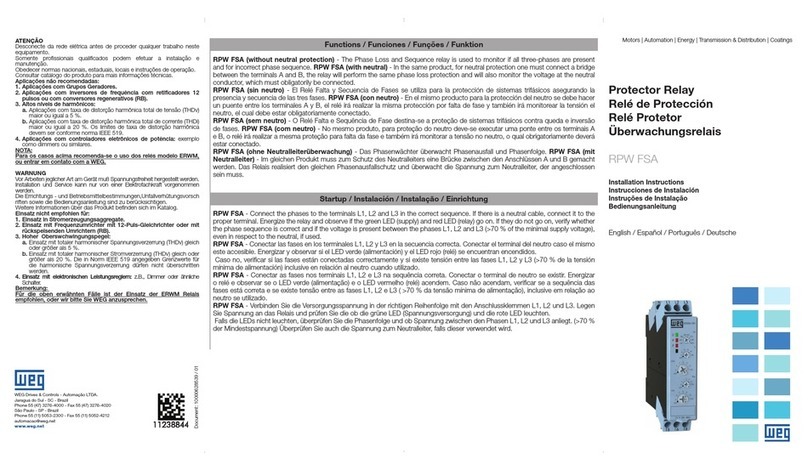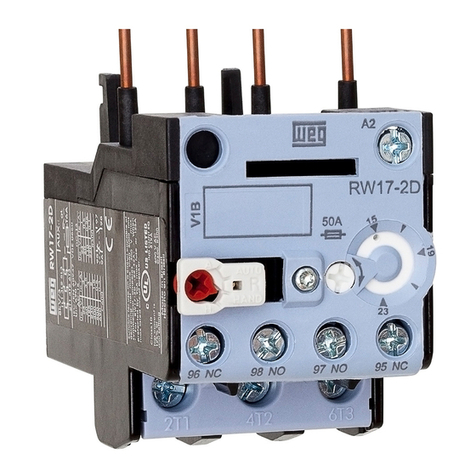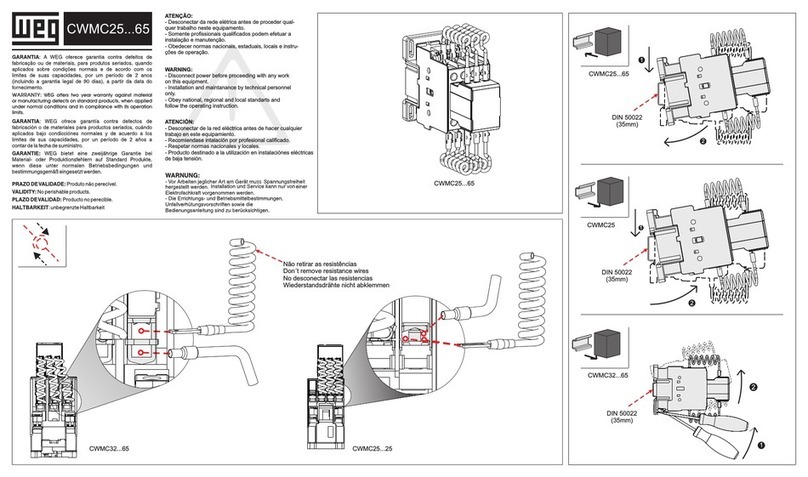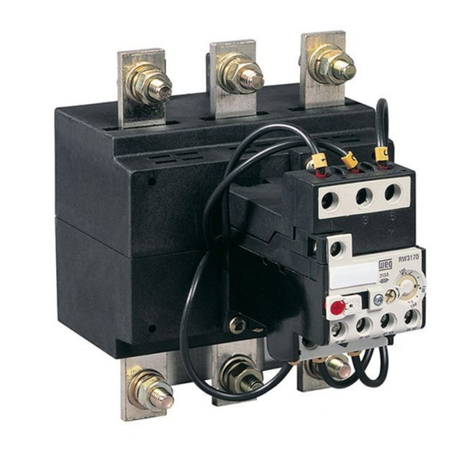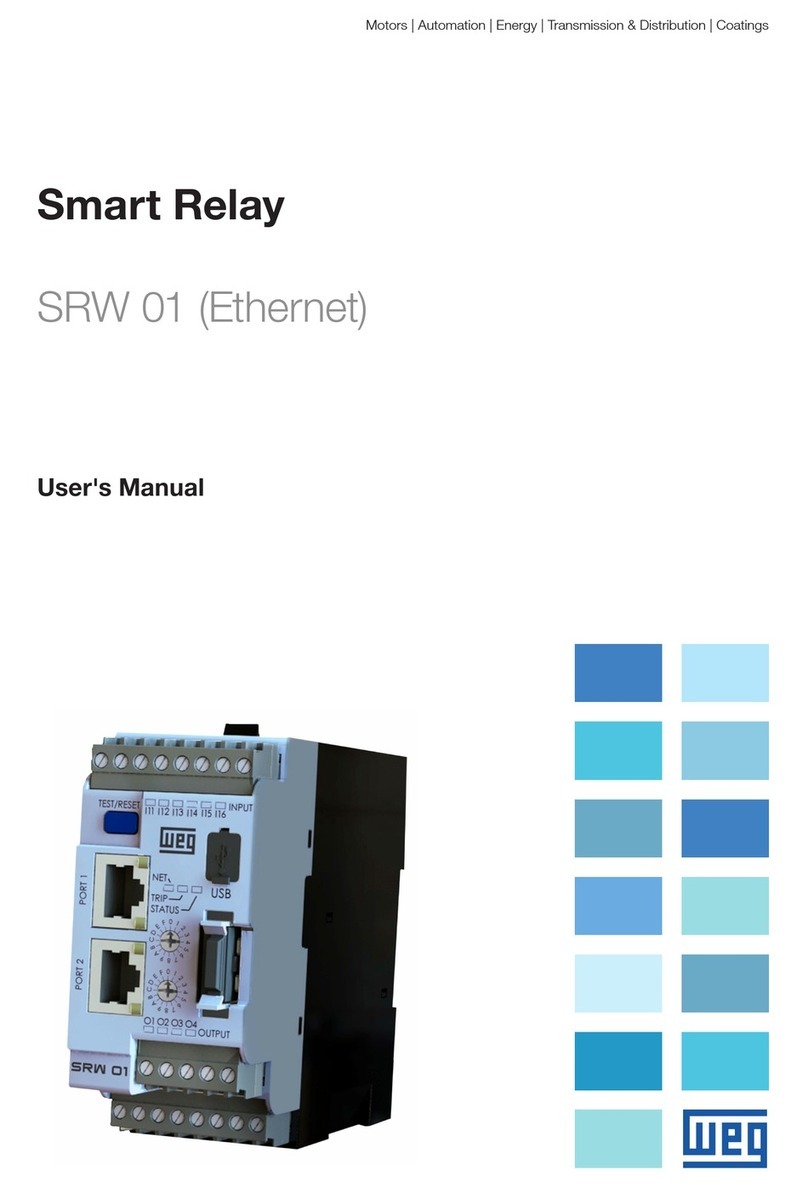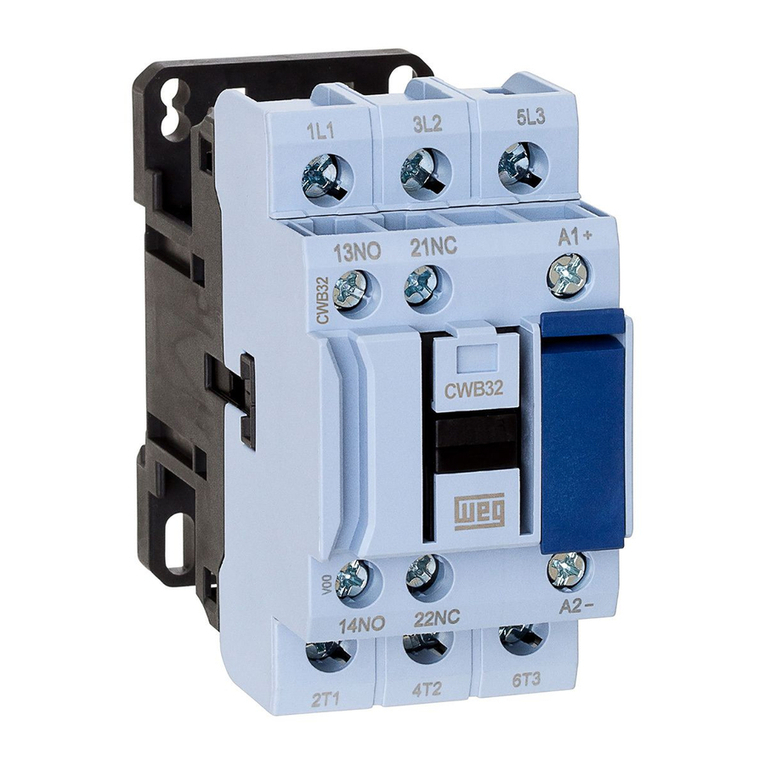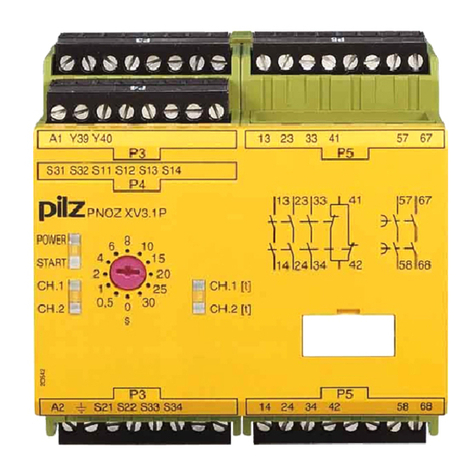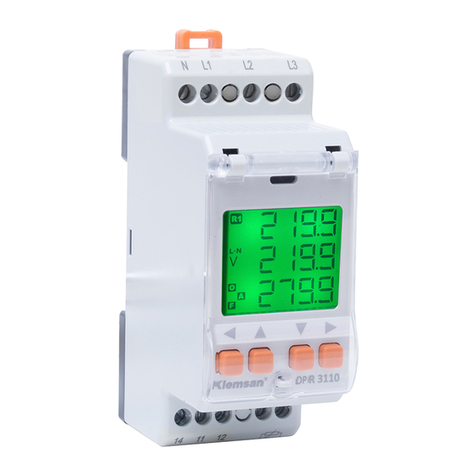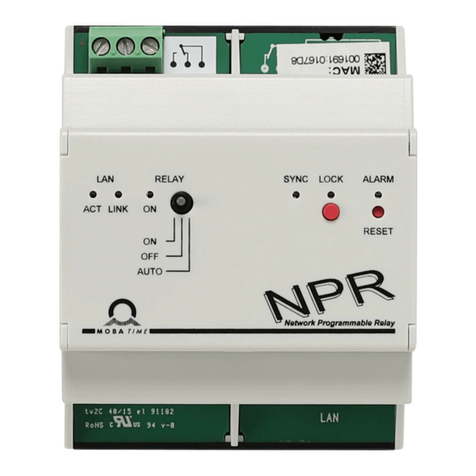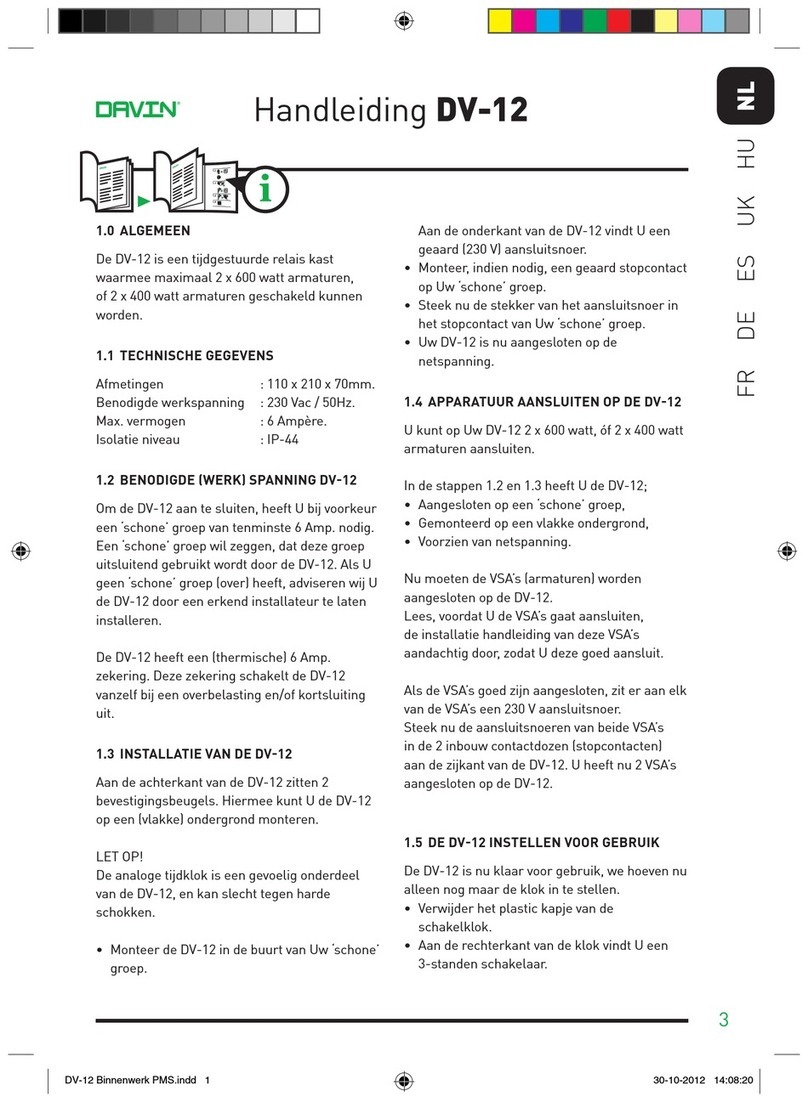WEG PSRW User manual

User's Manual
PSRW
Programmable Safety Relay WEG
Motors | Automation | Energy | Transmission & Distribution | Coatings


User’s Manual
Series: PSRW
Language: English
Document: 10005909449 / 01
Publication Date: 05/2019

Summary of Reviews
The information below describes the revisions made to this manual.
Version Review Description
- R00 First edition
- R01 New review

Contents
1 INTRODUCTION ..................................................................................... 1-1
1.1 WARNINGS ........................................................................................................... 1-1
1.2 ABBREVIATIONS .................................................................................................. 1-2
1.3 APPLICABLE STANDARDS ................................................................................. 1-2
2 DESCRIPTION......................................................................................... 2-1
3 MOUNTING ............................................................................................. 3-1
3.1 MECHANICAL FIXING.......................................................................................... 3-1
3.2 OVERVIEW ............................................................................................................ 3-1
3.3 CALCULATION OF SAFETY DISTANCE OF AN ESPE CONNECTED TO
PSRW .......................................................................................................................... 3-2
3.4 ELECTRICAL CONNECTIONS............................................................................. 3-2
3.5 INSTRUCTION TO CABLE AND TERMINALS .................................................... 3-3
3.6 USB INPUT............................................................................................................3-3
3.7 CONNECTION EXAMPLE OF PSRW TO MACHINE CONTROL SYSTEM........ 3-4
3.8 CHECK LIST AFTER INSTALLATION .................................................................. 3-4
4 OPERATION DIAGRAM .......................................................................... 4-1
5 SIGNALS.................................................................................................. 5-1
5.1 DIGITAL INPUTS................................................................................................... 5-1
5.1.1 Contact Filter and Reset............................................................................. 5-1
5.1.2 Input Type: Electrical/Mechanical Contact Input ..................................... 5-1
5.1.3 Input Type: PNP Input ................................................................................. 5-1
5.1.4 Input Type: Simultaneity Control................................................................ 5-2
5.2 RESET INPUTS..................................................................................................... 5-2
5.3 RESET ................................................................................................................... 5-3
5.4 AUXILIARY OUTPUT............................................................................................ 5-3
5.5 TEST OUTPUTS.................................................................................................... 5-4
5.6 OSSD OUTPUTS................................................................................................... 5-4
6 TECHNICAL SPECIFICATION ................................................................ 6-1
6.1 SAFETY LEVEL ..................................................................................................... 6-1
6.2 TECHNICAL SPECIFICATIONS ........................................................................... 6-1
6.3 ENCLOSURE......................................................................................................... 6-1
6.4 MECHANICAL DIMENSIONS .............................................................................. 6-2
7 DIAGNOSIS ............................................................................................. 7-1
8 CONNECTION EXAMPLES .................................................................... 8-1
8.1 EMERGENCY STOP CONNECTION EXAMPLE ................................................. 8-1
8.2 TWO HANDS CONTROL CONNECTION EXAMPLE .......................................... 8-1
8.3 SAFETY SENSOR CONNECTION EXAMPLE ..................................................... 8-2
8.4 LIGHT CURTAIN CONNECTION EXAMPLE ....................................................... 8-2
8.5 RESET INPUTS..................................................................................................... 8-3
8.6 AUXILIARY OUTPUT CONNECTION .................................................................. 8-4
8.7 OSSD OUTPUT CONNECTION ........................................................................... 8-5

Contents
9 PROGRAMMING WITH WPS.................................................................. 9-1
9.1 WPS INSTALLATION ........................................................................................... 9-1
9.2 APPLICATION SET UP ......................................................................................... 9-2
9.2.1 Menu ............................................................................................................ 9-2
9.2.2 Creating a Project ....................................................................................... 9-3
9.3 SETTING UP COMMUNICATION ........................................................................ 9-7
9.4 WIZARDS ............................................................................................................ 9-10
9.4.1 Wizard configurator .................................................................................. 9-10
9.4.2 Wizard Monitor .......................................................................................... 9-11
9.5 DESIGNING A CONFIGURATION ...................................................................... 9-11
9.5.1 Configuring the Inputs .............................................................................. 9-12
9.5.2 Logic and delay timer configuration ....................................................... 9-13
9.5.3 OSSD output and auxiliary output configuration ................................... 9-14
9.6 TRANSFERRING CONFIGURATIONS .............................................................. 9-15
9.7 RETRIEVING CONFIGURATIONS FROM PSRW .............................................. 9-19
9.7.1 Saving configurations on PC.................................................................... 9-20
10 PRODUCT USE WITH SAFETY .......................................................... 10-1
11 MODIFICATIONS................................................................................. 11-1
12 DECLARATION OF CONFORMITY .................................................... 12-1

Introduction
PSRW | 1-1
1
1 INTRODUCTION
This manual contains the instructions for the correct use of the PSRW device and safety information.
System description.
Method of Installation.
Connections.
Inputs / outputs.
Troubleshoot.
Use of the configurator tool.
1.1 WARNINGS
The following safety warnings are used in this manual:
ATTENTION!
This alert symbol indicates necessary attention to potential hazard or risk. If not follow the
recommendation may cause dangerous situations to user or process.
ATTENTION!
The PSRW is built according following safety levels:
SIL3 IEC 61508
SILCL 3 IEC 62061
PL e / Cat 4 ISO 13489-1
However, the definitive SIL and PL of the application will depend on the number of safety components,
their parameters and the connections that are made, as per the risk analysis.
ATTENTION!
Perform a risk analysis to determine the appropriate safety level for your specific application, using all
the applicable standards.
ATTENTION!
The configuration of the PSRW is the responsibility of the installer or user.
ATTENTION!
The device must be installed/configured in accordance with the application specific, risk analysis and
all the applicable standards.
ATTENTION!
Reference should be made to the handbooks and the relative product and/or application standards to
ensure correct use of devices connected to the PSRW within the specific application.
ATTENTION!
The ambient temperature in the place where the system is installed must be compatible with the
operating temperature parameters stated on the product label and in the specifications.
ATTENTION!
For all matters concerning safety, if necessary, contact your country’s competent safety authorities or
the competent trade association.

Introduction
1-2 | PSRW
1
1.2 ABBREVIATIONS
PSRW: Programmable Safety Relay WEG.
OSSD: output signal switching device: solid state safety output.
PFH(1/h): probability of a dangerous failure per hour.
SFF: safe failure fraction.
MTTFd: mean time to dangerous failure.
PFDavg: probability failure average dangerous.
SIL: safety integrity level.
SIL CL: safety integrity level claim limit.
PL: performance level.
CAT: category.
ESPE: electrosensitive safety protection device.
EDM: external device monitoring.
WPS: WEG Programming Suite.
1.3 APPLICABLE STANDARDS
PSRW complies with the following European Directives:
2006/42/UE “Machinery Directive”.
2004/108/UE “Electromagnetic Compatibility Directive”.
2006/95/UE “Low Voltage Directive”.
2011/95/UE “RoHS Directive”.

Introduction
PSRW | 1-3
1
And according to following standards:
EN ISO 13849 Safety of machinery – Safety-related parts of control systems – Part 1 and 2
IEC 61508 Part 1-7 Functional Safety of Electrical/Electronic/Programmable electronic safety-related systems
IEC 62061 Safety of Machinery – Functional Safety of safety-related electrical, electronic and programmable electronic
control systems
IEC61000-6-7 Electromagnetic compatibility (EMC) – Part 6-7: Generic standards – Immunity requirements for equipment
intended to perform functions in a safety-related system (functional safety) in industrial locations
IEC 61131-2 Programmable controllers – Part 2: Equipment requirements and tests

Introduction
1-4 | PSRW
1

Description
PSRW | 2-1
2
2 DESCRIPTION
The PSRW is a configurable safety relay that can be programmed via WPS graphical interface. It has 4 (four)
dual-channel safety inputs and 2 (two) OSSDs (dual-channel safety outputs) with configurable (manual/automatic)
individual reset.
PSRW is capable of monitoring the following safety sensors and components:
Safety Light curtain.
Two hands control.
Emergency stops.
Magnetic sensors.
Mechanical switches.
Safety sensors.

Description
2-2 | PSRW
2

Mounting
PSRW | 3-1
3
3 MOUNTING
3.1 MECHANICAL FIXING
The PSRW adopt a 35mm DIN rail.
To proceed the fixation use the follow sequence:
1º step, fitting on rail.
2º step, spring action.
3º step, lock.
Figure 3.1: DIN rail 35 mm mounting
3.2 OVERVIEW
Pluggable blocks
Front view
Identification pin
Back view
USB port
Led’s indicator
Identification pin
Technical label
Pluggable blocks
Bracket for
DIN Rail 35
mm
Figure 3.2: Main components of the PSRW

Mounting
3-2 | PSRW
3
3.3 CALCULATION OF SAFETY DISTANCE OF AN ESPE CONNECTED TO PSRW
Any Electro-sensitive Protective Equipment device connected to PSRW, must be positioned at a distance equal to
or greater than the minimum safety distance “S” so that the dangerous point can be reached only after stopping
the dangerous movement of the machine.
ATTENTION!
The standard ISO 13855 provides the information to calculate the proper safety distance.
ATTENTION!
Carefully read the installation manual of each device for specific information on the positioning distance.
ATTENTION!
Remember that the total response time depends on:
PSRW response time + ESPE response time + response time of the machine.
3.4 ELECTRICAL CONNECTIONS
The PSRW is provided with removable of terminal blocks for the electrical connections and has 6 terminal blocks
with 4 pins each one:
Table 3.1: Terminals of PSRW
Pin Label Type Description Operation
1 A1 Supply 24 Vdc
2 GND PE Ground
3 TEST_A Output Output to detect faults PNP (active at high level)
4 TEST_B Output Output to detect faults PNP (active at high level)
5 TEST_A Output Output to detect faults PNP (active at high level)
6 TEST_B Output Output to detect faults PNP (active at high level)
7 GND PE Ground
8 A2 Supply 0 Vdc
9 RST_1 Input Reset 1 Digital input (IEC 61131-2)
10 OSSD_1A Output Solid state 1 channel A PNP (active at high level)
11 OSSD_1B Output Solid state 1 channel B PNP (active at high level)
12 AUX_1 Output Auxiliary output / status 1 PNP (active at high level)
13 RST_2 Input Reset 2 Digital input (IEC 61131-2)
14 OSSD_2A Output Solid state 2 channel A PNP (active at high level)
15 OSSD_2B Output Solid state 2 channel B PNP (active at high level)
16 AUX_2 Output Auxiliary output / status 2 PNP (active at high level)
17 IN_1A Input Channel A input 1 Digital input (IEC 61131-2)
18 IN_1B Input Channel B input 1 Digital input (IEC 61131-2)
19 IN_2A Input Channel A input 2 Digital input (IEC 61131-2)
20 IN_2B Input Channel B input 2 Digital input (IEC 61131-2)
21 IN_3A Input Channel A input 3 Digital input (IEC 61131-2)
22 IN_3B Input Channel B input 3 Digital input (IEC 61131-2)
23 IN_4A Input Channel A input 4 Digital input (IEC 61131-2)
24 IN_4B Input Channel B input 4 Digital input (IEC 61131-2)

Mounting
PSRW | 3-3
3
3.5 INSTRUCTION TO CABLE AND TERMINALS
Terminal tightening torque: 5 ÷ 7 lb-in (0.6 ÷ 0.7 Nm).
Wire size range: AWG 12 ÷ 30, (solid/stranded).
Use 60/75 °C (140/167 °F) copper (Cu) conductor only.
We recommend the use of separate power supplies for the PSRW to other electrical power equipment (electric
motors, inverters, frequency converters) or other sources of disturbance.
Cables used for connections of longer than 50 m must have a cross-section of at least 1 mm2(AWG16).
ATTENTION!
Install the PSRW in an enclosure with a protection class of at least IP54.
ATTENTION!
Turn off the PSRW before connect the inputs/outputs.
ATTENTION!
The supply voltage to the units must be 24 Vdc ± 20 % (PELV, in compliance with the standard EN
60204-1 (Chapter 6 TECHNICAL SPECIFICATION on page 6-1)).
ATTENTION!
Do not use the PSRW like supply to external devices.
ATTENTION!
The same voltage reference (0 Vdc) must be used for all system components.
3.6 USB INPUT
The PSRW includes a USB 2.0 connector for connection to a personal computer and access the configurator tool
WPS manual available for download on the website: www.weg.net.

Mounting
3-4 | PSRW
3
3.7 CONNECTION EXAMPLE OF PSRW TO MACHINE CONTROL SYSTEM
1
2
3
4
5
6
7
8
9
10
11
12
A1
GND
TEST_A
TEST_B
TEST_A
TEST_B
GND
A2
RST_1
OSSD_1A
OSSD_1B
AUX_1
RST_2
OSSD_2A
OSSD_2B
AUX_2
IN_1A
IN_1B
IN_2A
IN_2B
IN_3A
IN_3B
IN_4A
IN_4B
13
14
15
16
17
18
19
20
21
22
23
24
0 V
0 V
L1 K1 K2
B1
+ 24 V
+ 24 V
PSRW
K1 K2
PE
Emergency
Figure 3.3: Connection example
3.8 CHECK LIST AFTER INSTALLATION
The PSRW is able to detect the internal faults. Anyway to assure the correct operation, the user must perform the
following checks at start up and at least every one year:
Perform a complete system test.
Verify that all the cables are correctly inserted and the terminal blocks well screwed to PSRW.
Verify that all LEDs light on correctly.
Verify the right position of all sensors connected to PSRW.
Verify the right fixing of PSRW to DIN rail.
Verify that all the external indicators (lamps) work properly.

Operation Diagram
PSRW | 4-1
4
4 OPERATION DIAGRAM
Fixing to DIN Rail
Electrical connections PSRW to
external components
Connect to PC by USB Port
Transfer the configuration
Setting parameters by
software configuration tool
Close Communication
Is the transferred configuration
correct?
Complete test on the
machine and configuration
valid for the application?
Start system operation
No
No
Yes
Yes
Figure 4.1: Operation Diagram

Operation Diagram
4-2 | PSRW
4

Signals
PSRW | 5-1
5
5 SIGNALS
5.1 DIGITAL INPUTS
The PSRW has four (4) dual-channel safety inputs that can take up to three (3) different configurations, being
possible to individually configure contact filter and reset options. The inputs are identified by the name INx_y,
where ‘x’ is the input number (1 to 4) and ‘y’ is the channel (A or B). See Table 3.1 on page 3-2.
5.1.1 Contact Filter and Reset
The contact filter is used to prevent noise in the contact line from jeopardizing the input operation. There are only
two contact filter options: 4 milliseconds or 16 milliseconds. The users should choose the best option for their
application.
ATTENTION!
The filter time influences the response time of the PSRW and must be considered in the calculation of
the total response time:
PSRW response time = input filter + processing. See Section 6.2 TECHNICAL SPECIFICATIONS on
page 6-1.
It is possible to set the reset type for each input. When the option “reset dependent” is selected, it indicates to the
logic that the input depends on a manual reset.
When not selected, it indicates automatic reset.
When all inputs have the option “reset dependent” selected, the logic reset will be manual.
When all inputs do not have the option “reset dependent” selected, the logic reset will be automatic.
When the inputs have different selections for the option “reset dependent”, the logic reset will be mixed.
For further information, see Item 5.2 RESET INPUTS on page 5-2 and Item 5.3 Reset on page 5-3.
5.1.2 Input Type: Electrical/Mechanical Contact Input
This input type is used for safety devices with mechanical or electrical contact that do not provide energy; they
only close the circuit. Those devices can be pushbuttons, safety relay contacts, safety contactors, safety sensors
with isolated output, etc.
For this type of input, it is mandatory to use the test outputs in order to detect anomalies and short circuits.
For further information, see Chapter 8 CONNECTION EXAMPLES on page 8-1.
5.1.3 Input Type: PNP Input
This input type is used for safety devices that supply energy when activated (PNP Output). Safety devices with
PNP output generate pulses on the output channels for internal diagnostics. The PSRW recognizes such devices
through these pulses, and their absence will result in an input fault. Those devices can be light screens, safety
controllers, safety PLCs, safety sensors, etc.
To differentiate the test pulses from an actual event, the PSRW uses the following reference:

Signals
5-2 | PSRW
5
Tep
Tp
INx_A
INx_B
Tp = pulse time
Tep = time between pulses
Figure 5.1: Example of test pulses
For the PSRW to identify the pulses as test pulses, ‘Tp’ cannot be longer than 1 millisecond, and ‘Tep’ cannot be
longer than 50 milliseconds.
For further information, see Chapter 8 CONNECTION EXAMPLES on page 8-1.
5.1.4 Input Type: Simultaneity Control
This type of input is used to control the simultaneity between two actuators. The two actuators must have
electromechanical contacts and be connected to the test output circuit.
The maximum simultaneity time is 0.3 seconds according to ISO13851.
Since two actuators are used, two PSRW inputs will be used, allowing only two simultaneity controls per PSRW.
The simultaneity control can only match: Input 1 and 2 or Input 3 and 4.
The actuators must contain NO and NC contacts and be connected to the PSRW so that the test output channels
are reversed. At the first input (1 or 3), the NO contact must be connected to channel A and the NC contact to
channel B. At the second input (2 or 4), the NC contact must be connected to channel A and the NO contact to
channel B.
For further information, see Chapter 8 CONNECTION EXAMPLES on page 8-1.
5.2 RESET INPUTS
The PSRW has two reset inputs: RST_1 and RST_2.
They are used to validate the state of the digital inputs IN_1, IN_2, IN_3 and IN_4. Each reset input is exclusively
related to its respective safety output.
RST_1
OSSD_1
ch A
ch B
RST_2
OSSD_1
ch A
ch B
(a) Input RST_1 (b) Input RST_2
Figure 5.2: (a) and (b) Reset inputs
To increase the safety level of the application, it is recommended to use an EDM connected in series with the reset
inputs, regardless of the configured operating mode.
The reset inputs are configurable by the user and can operate in automatic, manual or mixed (manual and
automatic simultaneously) mode according to the application requirements.
For the automatic mode, the reset validation takes place immediately after each transition of the digital inputs,
provided that the reset input is at high level (+ Vdc).
Table of contents
Other WEG Relay manuals
Popular Relay manuals by other brands
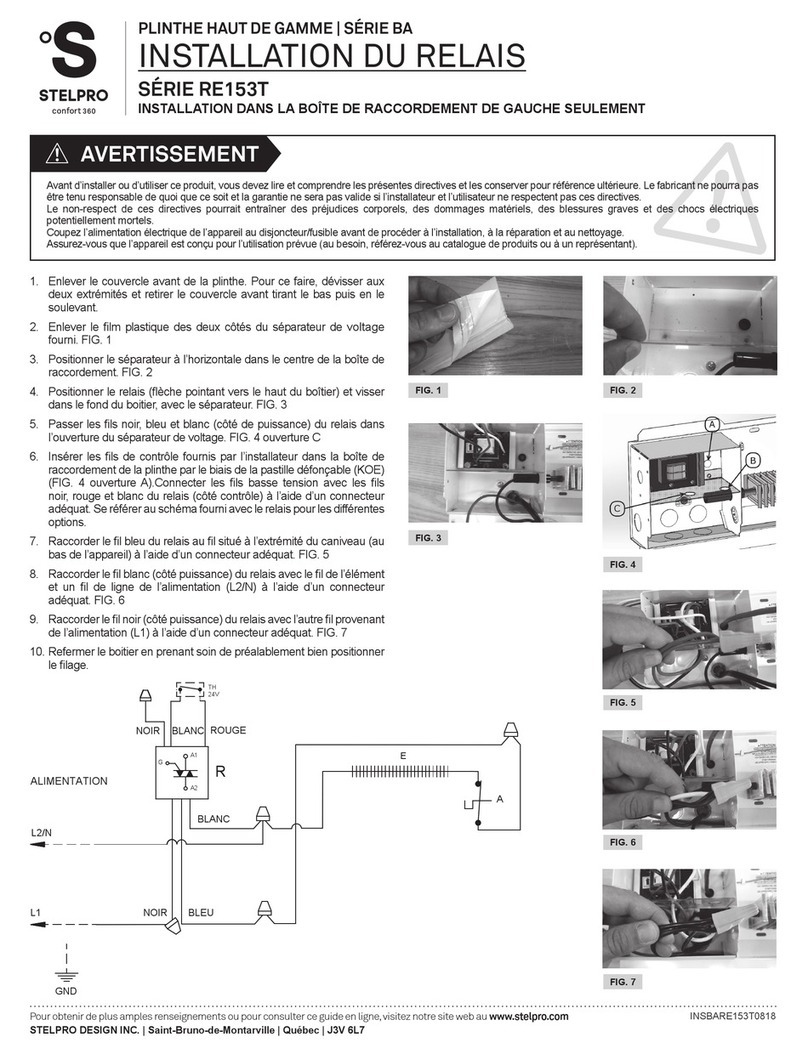
Stelpro
Stelpro BA Series Installation
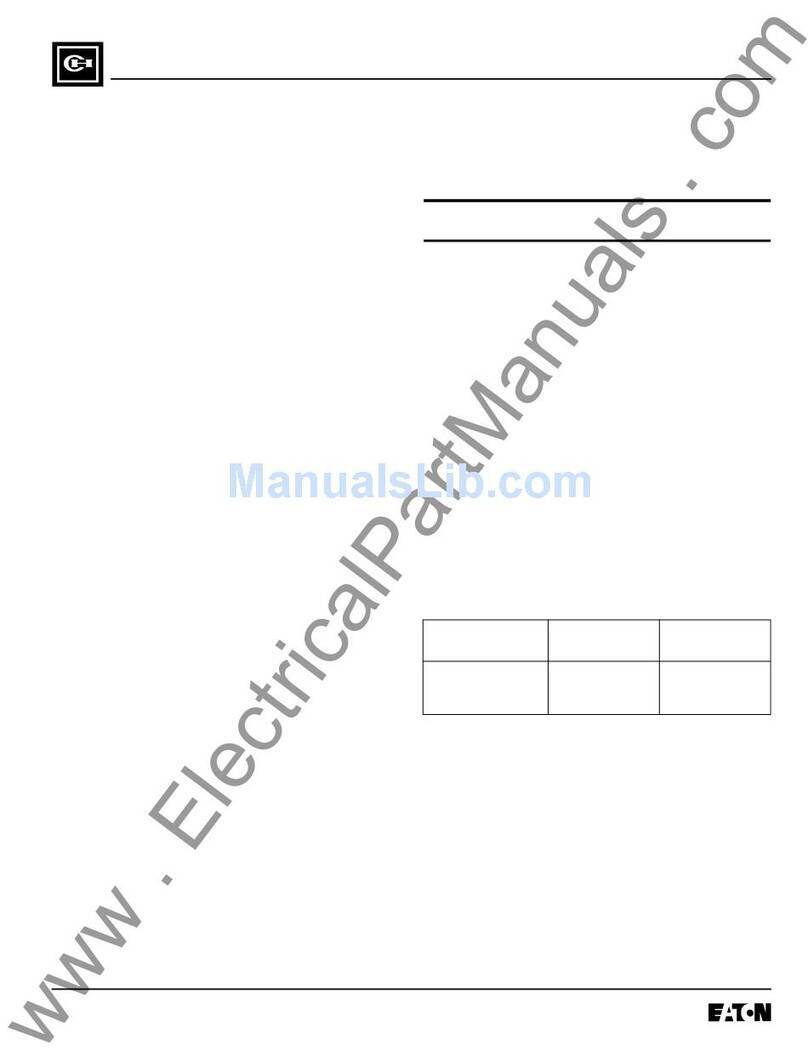
Eaton
Eaton Digitrip RMS 510 LI instruction manual

ehb electronics
ehb electronics ehb5040 Series operating instructions
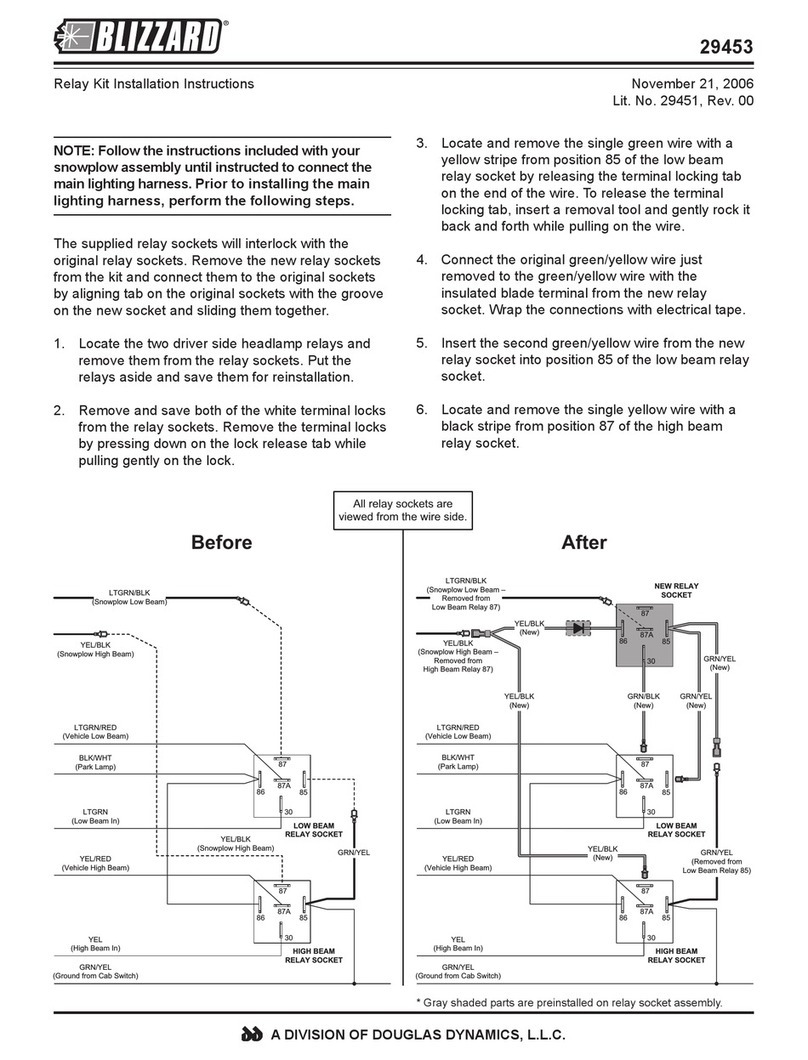
Blizzard
Blizzard 29453 installation instructions

ASO Safety Solutions
ASO Safety Solutions ELMON 31 operating manual
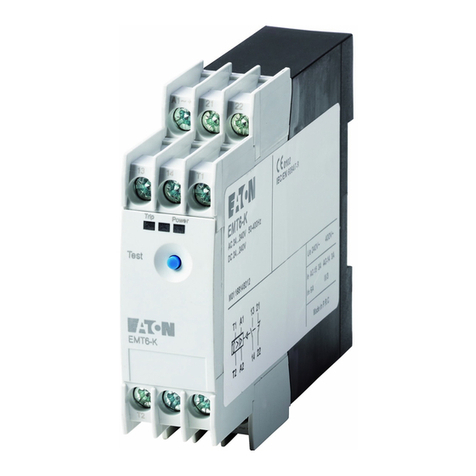
Moeller
Moeller EMT6 installation instructions
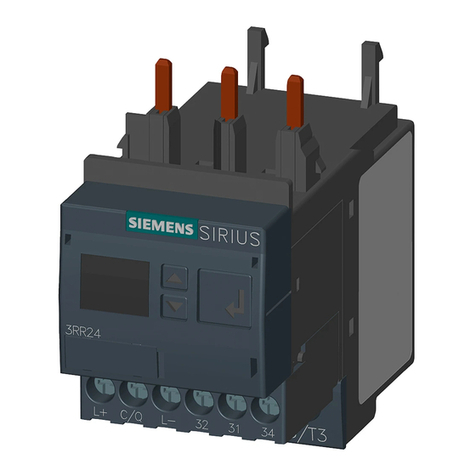
Siemens
Siemens SIRIUS 3RR2443-1AA40 operating instructions
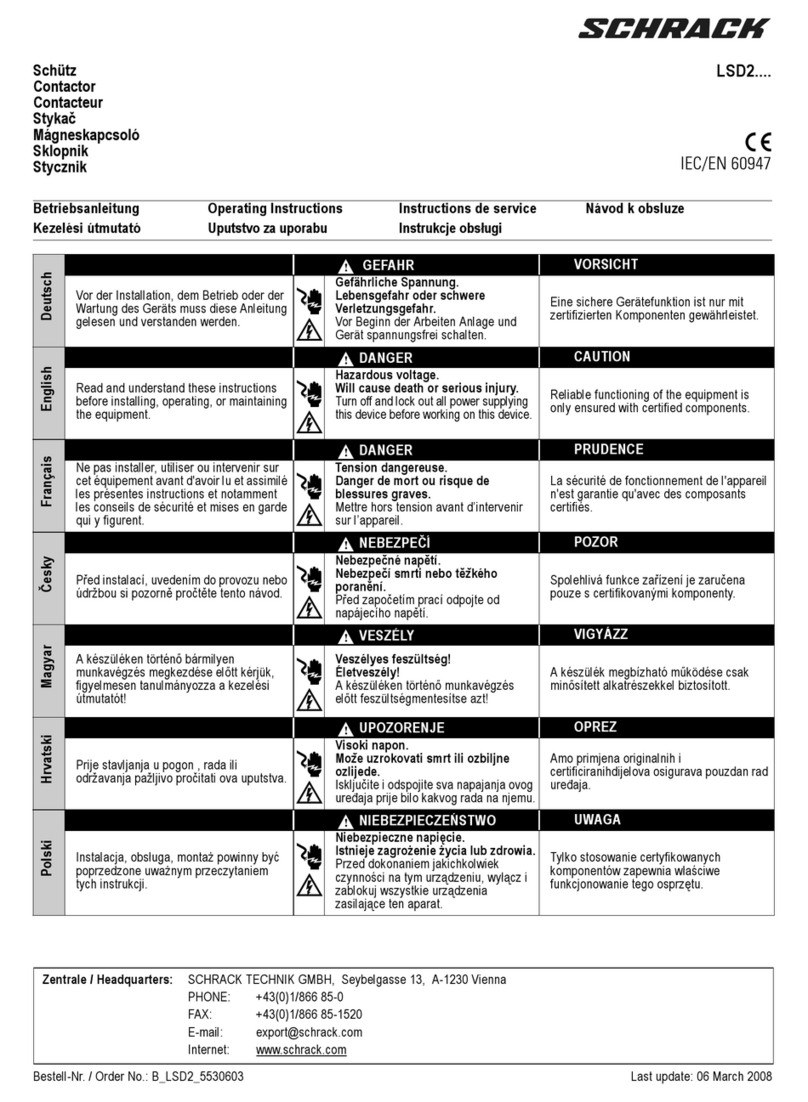
Schrack
Schrack LSD2 Series operating instructions
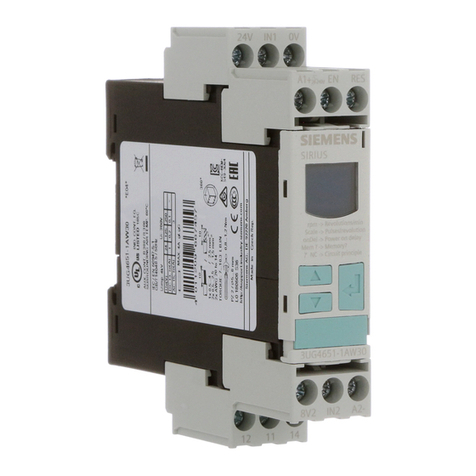
Siemens
Siemens Sirius 3UG4651 operating instructions
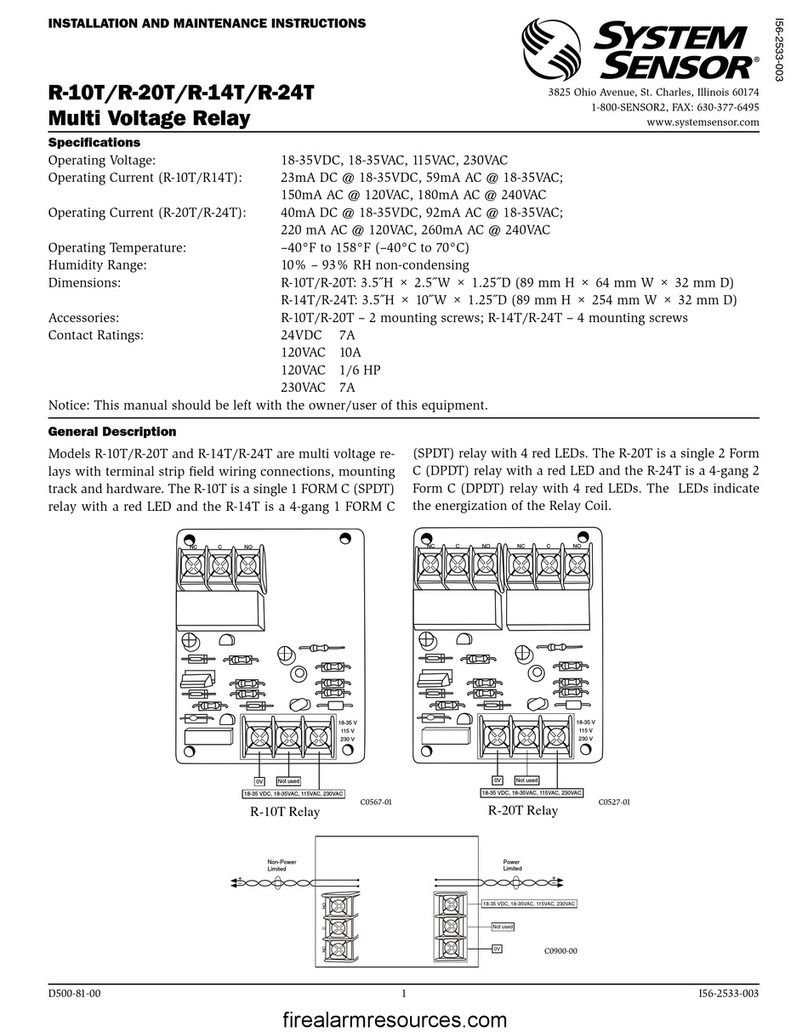
System Sensor
System Sensor R-10T Installation and maintenance instructions
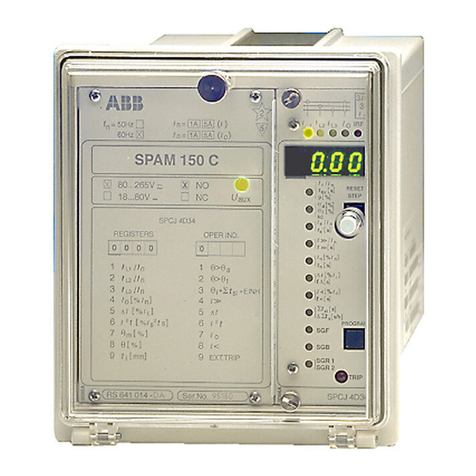
ABB
ABB SPAM 150 C User manual and technical description

Eaton
Eaton ESR5-NE-51-24VAC-DC manual
